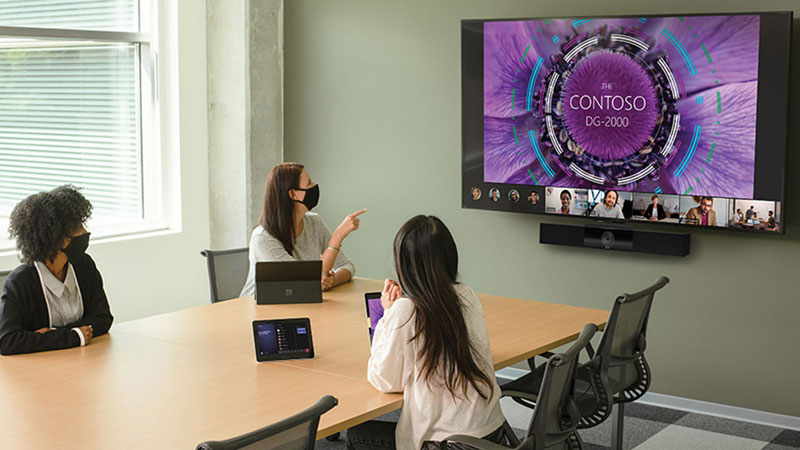
Hybrid work and the year ahead
 Like many of you, I’m looking at 2022 as an opportunity to continue evolving as a leader and to experiment with new ways to help my team thrive in a hybrid world. I talked a bit about what I think is next for hybrid work in my post last month. That’s why for this year I’m focused on new skills, new tools, and finding ways to balance the amount of time we spend collaborating versus completing tasks and projects, not only in terms of driving productivity, innovation, and engagement, but also to help ensure good work-life balance.
Like many of you, I’m looking at 2022 as an opportunity to continue evolving as a leader and to experiment with new ways to help my team thrive in a hybrid world. I talked a bit about what I think is next for hybrid work in my post last month. That’s why for this year I’m focused on new skills, new tools, and finding ways to balance the amount of time we spend collaborating versus completing tasks and projects, not only in terms of driving productivity, innovation, and engagement, but also to help ensure good work-life balance.
In hybrid work environments, connections are key
One of the biggest things I think we’ve all learned over the past two years is that non-stop video calls, emails, and chats have turned into digital overload and impacted our well-being. The intensity of our workdays, and what we expect of our teams, has increased significantly.
Enabling flexibility, balanced with strengthening connections across my team while promoting well-being, is a challenge I think all leaders are facing. Meetings will continue to be vital for all our organizations, but we need to find ways to structure them to align with when, where, and how our people work today to ensure that every participant feels included—whether they’re joining from a conference room, home office, or on the go. Check out these top hacks, tips, and tricks that can help transform your meeting experiences, which was recorded by Chris Smellie, a member of my team.
Part of leading with flexibility in our hybrid world means providing the right collaboration tools and spaces that simplify communication and level the playing field for all employees. As you might expect, my team uses Microsoft Teams to stay connected with voice and video across all our devices. Having just one app that brings together all collaboration needs like chat, meetings, and calling has helped us manage digital overload and stay organized. And while having the right tools is important, I’m also learning that meeting spaces play a vital role in facilitating strong connections and collaboration. We use Microsoft Teams Rooms to help us setup meetings in ways that remove barriers between spaces, places, and people, and deliver inclusive meeting experiences with all participants in mind.
If you would like to learn more about how you can find the right balance between flexibility and collaboration for your team, I would encourage you to join one of our upcoming virtual training events with a Microsoft expert.
Insights from frontline workers
At Microsoft, we’re continuously studying how the way people work is changing and how technology can empower people in every dimension of their life. While we typically talk about how hybrid work has impacted information workers, we recently turned our focus to the frontline workers—some of the real heroes of the pandemic—who kept our grocery stores stocked, delivered our packages, and provided so many of us with essential healthcare services.
Their achievements have not been easy. The effects of stress are real, serious, and for many frontline workers, persistent, with 58 percent of them expecting their work stress either to stay the same or get worse over the next year. That’s why I was so glad to see that our latest Work Trend Index Special Report on Frontline Workers focused on listening to their feedback.
You should check out the whole report, but some of the key findings that I think apply to all workers highlight the need for companies to prioritize culture and communication from the top, provide flexibility and work-life balance where possible, modernize training, and leverage technology to help reduce workplace stress. With frontline workers a huge part of so many industries, this research is not only broadly relevant, but insightful and incredibly timely.
Find the right approach to hybrid work
There’s no one-size-fits-all approach to hybrid work. Organizations with workers who need to connect and collaborate in a variety of settings have even more decisions to make about how to leverage technology to improve their workflows and empower their teams.
Many of us are trying to solve the challenges of hybrid work in ways that fit the unique structure of our own organizations. When thinking about the best approach for my team, I’m finding it helpful to talk through ideas with my peers and to get feedback from leaders at every level of my organization. Microsoft can help you do the same as you explore what’s best for your team. Consider joining one of our upcoming Art of the Possible events. These sessions are designed to inspire your thinking around how to keep your team connected in a hybrid world through conversations with your peers.
I’m excited by what we can all learn from our teams, and each other, in the coming year and look forward to sharing my own experiences and observations with you along the way.




